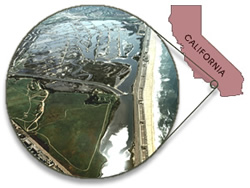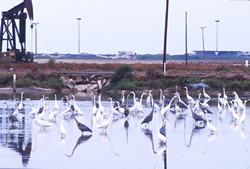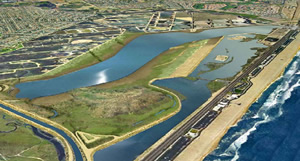Contact EPA Pacific Southwest Water Division
Pacific Southwest, Region 9
Serving: Arizona, California, Hawaii, Nevada, Pacific Islands, Tribal Nations
Bolsa Chica Wetland Restoration Project
National Information
State
and Local Resources

- U.S. Fish and Wildlife Service - Bolsa Chica Restoration
- NOAA Bolsa Chica Restoration
- U. S. Army of Corps of Engineers
Los Angeles District - California Coastal Conservancy
- California Coastal Commission
- California State Lands Commission
- California Department of Fish and Game
- Santa Ana Regional Water Quality Control Board

Aerial view of the Bolsa Chica wetlands as they appeared before the restoration project.
Landowners proposed extensive filling for urban development starting in the 1970s, but none of the proposals received the needed permit under Section 404 of the Clean Water Act. The law allows destruction of wetlands only when there is no practicable alternative. EPA recommended alternatives to limit development to the dry upland areas of the property. These local groups have also consistently supported protecting the wetlands:

Even in its present condition, the Bolsa Chica wetlands provide important habitat for egrets, blue herons, and other shorebirds.
In 1980, EPA began a three-year effort to carefully map the extent of the wetlands under Clean Water Act jurisdiction. This study strengthened the positions of federal agencies working to protect and restore the wetlands.
In the mid-1990s, EPA helped broker an interagency agreement to use mitigation funds from the Ports of Los Angeles and Long Beach to purchase the property and restore it. EPA was instrumental in negotiating agreements with the oil rig operators to clean up the site.
The State Lands Commission, the Coastal Conservancy and the U. S. Fish and Wildlife Service developed a wetland restoration plan under the guidance of the Bolsa Chica Wetlands Steering Committee – eight state and federal agencies, including EPA. The plan was subject to environmental impact studies, hearings, and much scrutiny. The $65 million project is expected to be complete in 2007.

Artist's conception of how the Bolsa Chica wetlands will look after restoration, at low tide.
Regulatory agencies such as the Army Corps of Engineers, the California Coastal Commission, and the Regional Water Quality Control Board played significant roles, as did resource agencies such as the U. S. Fish and Wildlife Service, National Marine Fisheries Service, California Department of Fish and Game, Coastal Conservancy, and State Lands Commission. EPA officials recognized EPA attorney Hugh Barroll and EPA wetlands expert Tom Yocom, among others, for their outstanding work on Bolsa Chica over the past 20 years.
More Information
- Bolsa Chica Project
description (and map)
– a more indepth description of the restoration.
